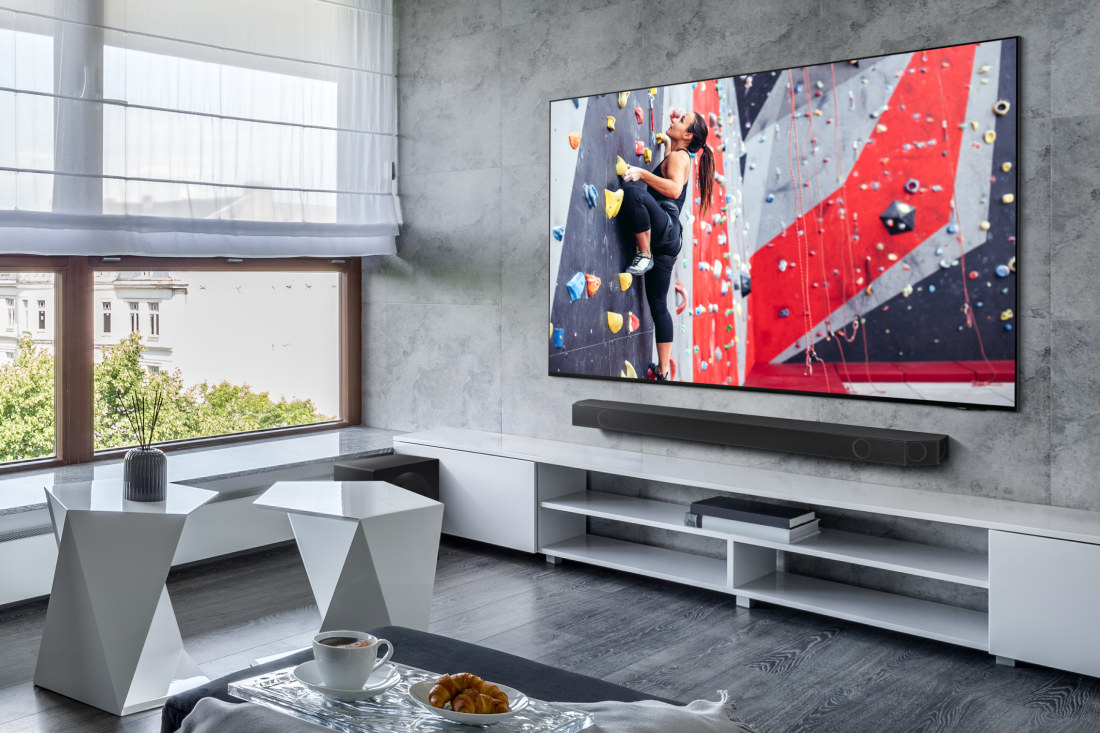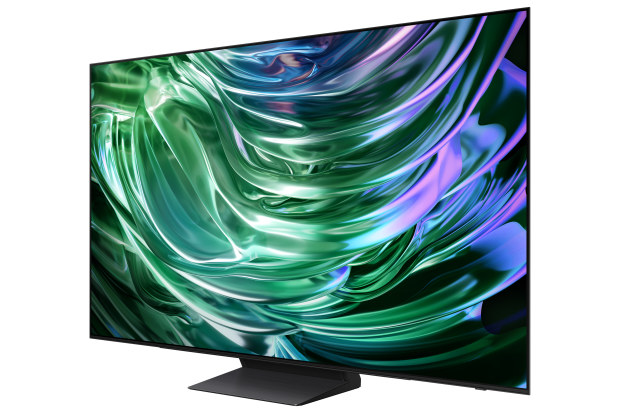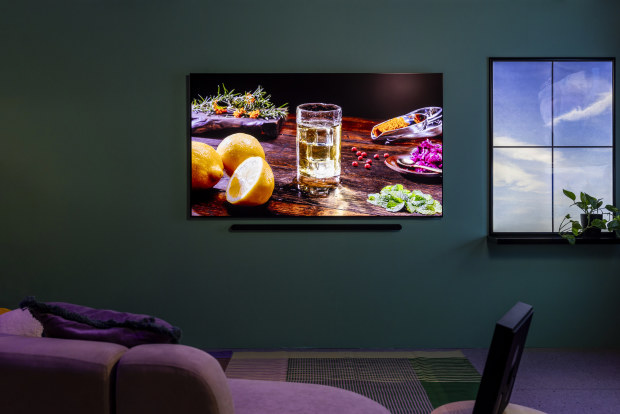Samsung’s new OLED TV is the best TV ever. Or is it?
The idea that anything could be inferior to this device has forced us to ponder the very essence of what it means to have eyes in your head.
There are, I have come to realise, two types of people in the world: those who are bothered by watching an LCD TV; and those who aren’t.
This latter classification is itself divided into two subtypes: those who aren’t bothered because they don’t see anything wrong with LCD TVs; and those who can see what’s wrong, but for some unfathomable reason aren’t bothered by it.

Samsung has added extra brightness, as well as an anti-glare filter to its latest OLED TV, to help it perform better in bright rooms.
We’ve been devising this taxonomy here in the Digital Life Labs due to the review we’ve been doing of Samsung’s latest non-LCD TV, the S95D OLED.
We think it’s the best TV Samsung has made, arguably the best TV anyone has made, but, weirdly, Samsung itself doesn’t see it that way.
Samsung thinks its top-of-the-line LCD TV, the Neo QLED 8K, is its best TV.
Now, we haven’t reviewed the Neo QLED 8K TV, and we won’t get to for a few weeks, but nevertheless this Samsung opinion seems like madness to us.
The idea that anything could be better than the S95D has forced us to ponder the essence of what it means to have eyes in your head.
Clearly, the engineers at Samsung have eyes in their heads. Without eyes, they could have never come out with a TV as magnificent as the S95D. The only explanation for their strange opinion must be this above-mentioned taxonomy, and the fact that they must have done the maths and figured out there are more people in camp #2 (not aware of or not bothered by the very obvious flaws in LCD) than there are in camp #1 (the purists).
You’ve probably figured out which camp we’re in.
We’re in the camp filled with people who see the way LCD TVs get dimmer and sometimes develop a colour cast when you watch them from the side of the living room, and think, ick!
We’re in the camp filled with people who see blooming in high-contrast areas of LCD TVs, such that the blacks have all turned milky grey, and think, erk!
We’re in the camp filled with people who see the dull colours of many LCD TVs and think, ugh!
Ours is the camp filled with people who look at OLED TVs, which display rich colours, no blooming whatsoever and, in the case of recent OLED screens, perfect viewing angles, and think, oh, thank god!

Different viewing angles are all perfect on the S95D OLED TV.
But we realise not everyone is like us. Indeed, as LCD TVs get better and their flaws become less visible and less bothersome, we see camp LCD swelling with people, and for good reason.
LCDs are a lot brighter than OLEDs, after all (though more on the brightness of this new Samsung OLED in a moment).
And they’re bigger, cheaper and more durable than OLED TVs, too, all of which matter and cannot be ignored by us OLED purists.
All of which is to say, we prefer the new S95D OLED over every other TV we’ve ever reviewed for a bunch of good reasons, but we acknowledge they are reasons that won’t matter to most people.
One good reason we think the S95D is Samsung’s best TV is its brightness.
It’s dramatically brighter than last year’s model, which is very surprising because last year’s S95C was itself a big leap forward for OLED TV brightness. Samsung claims the S95D is 20 per cent brighter than the S95C.
We’d say it’s at least that.
In any event, this TV just pops, and combined with how black its blacks are – perfectly black, due to the zero-blooming nature of OLED technology – the contrast levels are superb.
We’re very curious to see whether the LCD panel on the Neo QLED 8K can match the S95D for contrast. It will be brighter, for sure – the best LCD TVs are much brighter than the best OLEDs – but its blacks won’t be as black, and we wonder whether the overall picture quality will be better or worse as a result.
A corollary to this extra brightness is a new anti-glare layer that Samsung has added to the screen of the S95D, in the hope that people will start taking OLED TVs out of the darkened rooms that are their natural domain, and into the bright rooms where LCD TVs tend to rule.
The very effective glare filter doesn’t appear to have washed out the black levels at all (always a risk with anti-glare filters, given the way they diffuse light falling onto the screen), and it has noticeably improved the viewing experience both in fairly bright rooms, and in darkened rooms where a single light source such as a lamp can otherwise prove distracting.

The new anti-glare coating is inspired by Samsung’s Frame TVs.
Also, the filter gives the screen a nice, matte-black look, which makes the TV feel a little less intrusive when it’s turned off.
The third thing we like about the S95D is its improved upscaling and picture-enhancement technology.
There are other ways to separate humans into camps, one being to divide them into a) people who can happily watch horrible, low-resolution, 576i or 480p content on a big screen, and b) people with eyes.
We are very much in the “people with eyes” camp, yet we were perfectly delighted to watch 1080p content on the huge, 77-inch version of the S95D. (We tried 480p content, and didn’t care for it. We’re not barbarians.)
Honestly, even standing quite close to the TV, 1080p content looks great, barely distinguishable from content in the TV’s native 2160p format – ignoring the HDR content that’s available in the latter but not the former format – which to us is a very big deal.
Most streamed and broadcast content is still 1080p, and there’s no sign of that changing soon, even as screens get ever bigger. But with upscaling technology like this, who needs it to change?
Samsung says it’s now using 20 separate neural blah-blahs to upscale and enhance the image on this year’s premium TVs, which does smack of “Now With More Science” marketing bollocks to us, but whatever the company is doing, it’s working.
So, yes, for all of those reasons, we’re still in the OLED camp. But we acknowledge that people not in that camp may, indeed, have eyes.
Some of them.
Samsung S95D OLED Smart TV
- Likes | Insanely good picture. Extremely thin TV.
- Dislikes | The insanely thin remote is too easy to misplace.
- Price | $4640 for 55-inch model, $5800 for 65-inches and $9281 for 77-inches.
Read next in Digital Life
- At last, a gadget worthy of a bucket list Imagine what you could do with a portable, 300-inch screen and Hisense’s new C1 projector.
- One control panel for all your home devices is still a lot to ask So far, Amazon’s new Echo Hub is the best at controlling smart devices around the home. Nevertheless, the smart device industry remains fundamentally broken.
- Meet LG’s ‘world first’ TV in a suitcaseLG’s 2024 TV line-up includes 36 new models – and one very special offering that looks like it could be used to launch a nuclear attack.
- If you can get your hands on Fujifilm’s latest camera, doThere was very little wrong with the old Fujifilm X100V, other than it was so popular it was near-impossible to buy. The new X100VI has even fewer flaws, but still has that one.
- Can Asus’ two-screen Zenbook make you ditch Apple’s MacBook? Asus has absolutely nailed this year’s Zenbook Duo dual-screen notebook. It’s a pity Intel can’t nail it too and help Apple’s rivals really compete.
Subscribe to gift this article
Gift 5 articles to anyone you choose each month when you subscribe.
Subscribe nowAlready a subscriber?
Introducing your Newsfeed
Follow the topics, people and companies that matter to you.
Find out moreRead More

Latest In Technology
Fetching latest articles